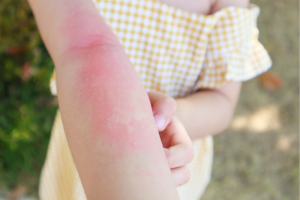Rashes in children are common and can be caused by many different things including but not limited to, fungal rashes, heat rashes, chickenpox, eczema and scabies. A rash is defined as an alteration in the color or texture of the skin.

SYMPTOMS:
- Pain
- Itching
- Oozing
- Crusting
- Peeling
- Chafing
- Bleeding
- Flaking
- Discoloration of the skin
CAUSES:
- Viruses
- Fungi
- Bacteria
- Infestations
- Allergies
- Autoimmune disorders
- Sexually transmitted diseases
OUTCOME:
The outcome of the rash depends on the cause. See each individual cause.
DISCUSSION:
Rashes in children includes many possibilities, each having a different cause. To adequately understand rash, each should be included in separate discussions. The following are possible causes:
- Viral Exanthem
- 5th’s Disease
- Varicella (Chicken Pox)
- Roseola
- Measles
- Mumps
- Rubella
- Scarlet Fever
- Rocky Mountain Spotted Fever
- Henoch-Schonlein Purpura
- Fungal Rash
- Rheumatic Fever
- Lyme Disease
- Impetigo Idiopathic
- Thrombocytopenic Purpura
- Scabies
TREATMENT:
The treatment for each rash depends on the cause.
ONE DOCTOR’S OPINION:
A rash in children is a very common reason to visit the pediatrician. Harmless, mostly irritating conditions cause most rashes. Some rashes, such as the petechiae of meningitis or sepsis, can indicate a severe illness. Fortunately, this is rare compared to the more common, harmless rashes. Petechiae are small, red pinpoint spots on the body that do not blanch. Blanching occurs when you pull the skin very taut on either side of the red spot, and the red spot disappears. It reappears when you release the skin. Although 15% of children with fever and petechiae have a serious illness, 85% have something very harmless. Coughing, straining, injury, or abuse can also cause petechiae. Many rashes are called maculopapular. Macules are large red blotches on the skin, and papules are smaller red spots. Vesicles are small spots filled with fluid. To better understand what each rash may be, see each individual discussion about the various causes of rashes.
This blog was written by Dr. Michael Bornstein, who has 30 years of experience as a pediatrician.
Disclaimer: The contents of this article, including text and images, are for informational purposes only and do not constitute a medical service. Always seek the advice of a physician or other qualified health professional for medical advice, diagnosis, and treatment.


FOLLOW US